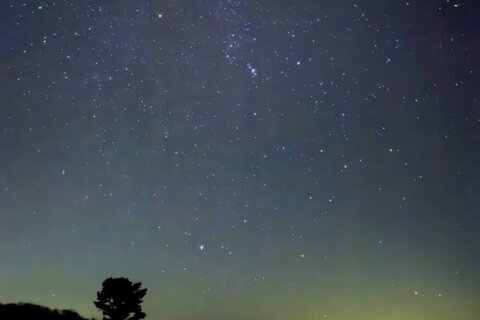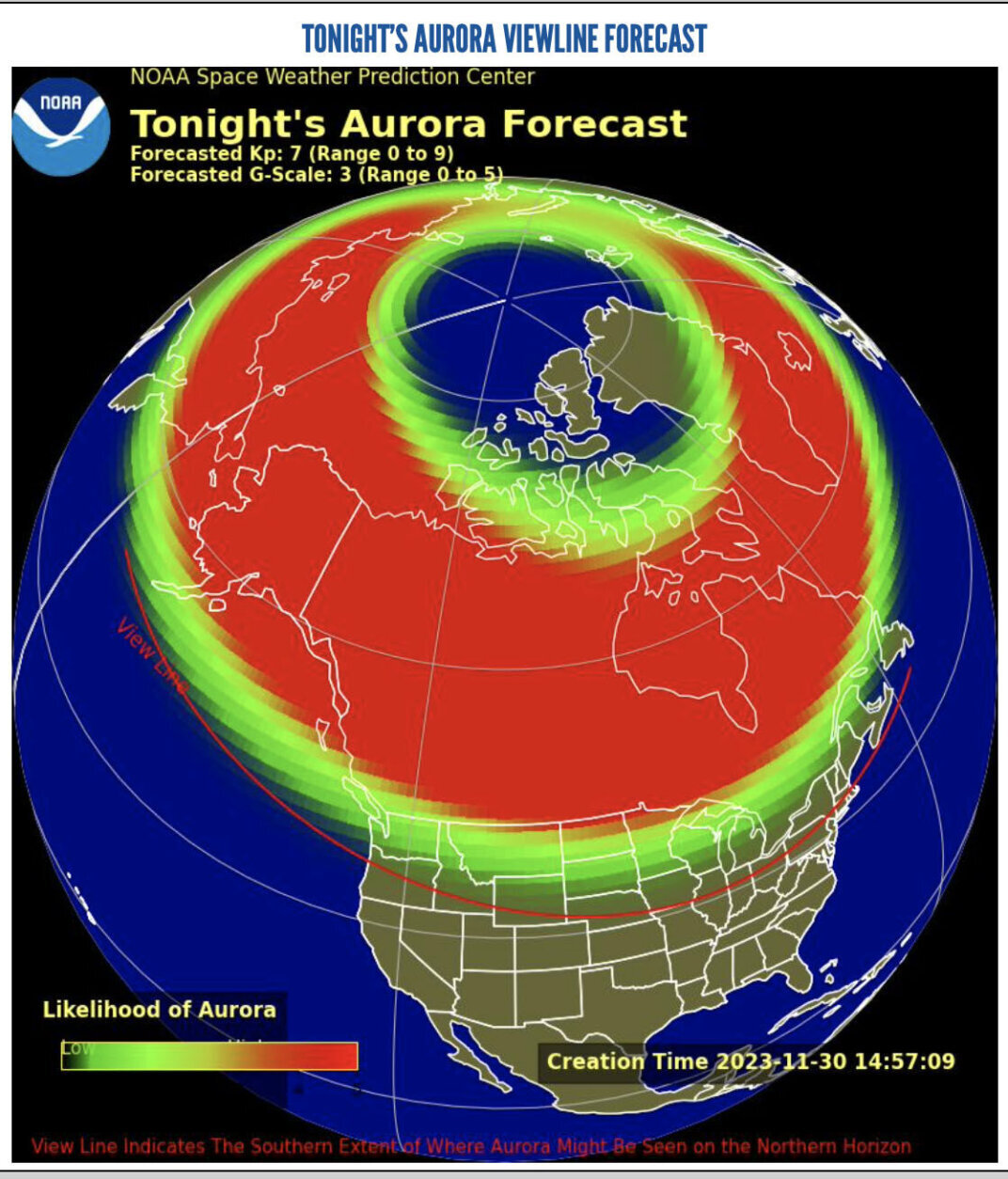
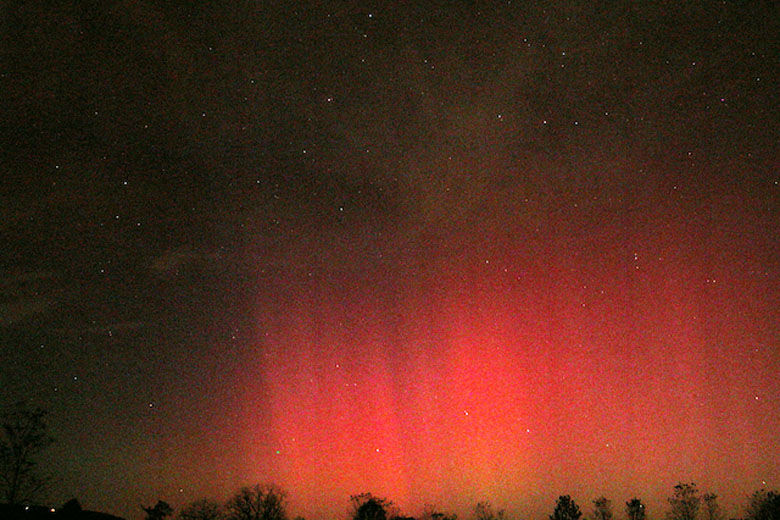
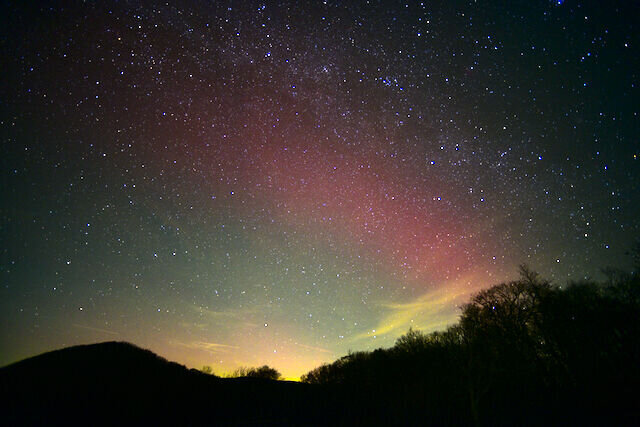
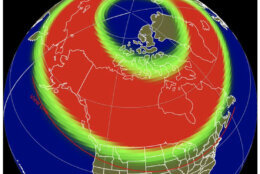
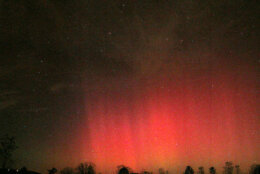
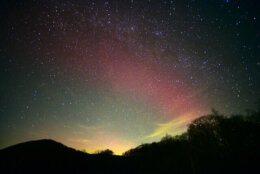
The D.C. area is enjoying a day of warming Thursday that will continue through the weekend — along with some much needed rain, which means clouds. But four big blobs of solar material violently ejected from the sun over the past several days are also due to impact earth.
Known as a fairly rare cannibal CME — Coronal Mass Ejection — when it impacts
the realm of near-earth space and our planet’s magnetic field, a strong geomagnetic storm, level G3, is forecast to occur Dec. 1. It is set to continue as a G2 storm that could produce an aurora — the Northern Lights — possibly visible in the U.S. on Thursday night into Friday morning, including in the D.C. region.
We experienced a geomagnetic storm that produced incredible sky views Nov. 5.
There are three critical factors to possibly seeing a sky show Thursday night: the timing of the G2-G3 geomagnetic storm, cloud cover and moon rise.
As to the geomagnetic storm levels, the National Oceanic and Atmospheric Administration (NOAA) is forecasting G2 levels Nov. 30, from 10 p.m. to 1 a.m. EST and G3 levels on Dec. 1, from 1 a.m. to 4 a.m. EST.
We luck out with cloud cover forecasts in the D.C. area, as we should have fairly clear skies. Moon rise will be in the Northeast just before 8 p.m. EST and will be in the sky all night. The moon will be bright, and if auroras are present, hopefully they will be bright enough to be visible in the moonlight.
The NOAA Space Weather Prediction Center Aurora Dashboard (Experimental) provides a two-day prediction of auroras. Northern U.S. states have a good chance of seeing them Thursday night, but the DMV region’s more southerly location makes it more “iffy.”
Our best bet is to monitor the NOAA and space-related social media sites spaceweather.com, EarthSky.org, and space.com for updates. The current forecast shows the aurora will be visible to northern states. It will be worth taking a look to the North-Northeast from a dark sky site with a clear horizon. You might be able to detect some color in the sky if auroras are present and bright enough to overcome moonlight, but they would likely be low on the Northern horizon. Wide field binoculars might help.
How to take pictures
Use a camera or smartphone that can take exposures of several seconds — including using “Night Sky” or “Low Light” settings if your camera has them — of the Northern horizon. Steady the camera or use a tripod for best image results. The camera may capture auroras that your eyes did not.
With our terrestrial weather being such a factor in our daily lives, we are also directly affected by space weather, which can produce a variety of events, including Thursday’s geomagnetic storm and auroras.
Space weather, like our terrestrial weather, is caused by Earth’s interaction with our star, the sun. We know it will be there every new day and count on it for life-giving warmth and energy. We also have become accustomed to it being well behaved. What many people may not know is that our sun undergoes an 11-year solar cycle that can affect space weather throughout our solar system.
Spaceweather.com — I check this site every day just as I do my local weather — has a daily snapshot of what the space weather in the solar system is going to be like and a current image of the sun. Their webpage Thursday has my astropic I took Nov. 5 of a Stable Auroral Red (SAR) Arc. I’m really hoping that we get a good sky show Thursday night.
Our sun is a 4.5-billion-year-old star that we have been monitoring since Galileo. Today, humans have a fleet of spacecraft that monitor the sun and space weather.
The sun is currently in Solar Cycle 25 and is progressing toward Solar Maximum, which is predicted to occur July 2025. As the sun approaches Solar Maximum, it produces more sunspots and solar events, which produce space weather events such as the forecast Level G3 Geomagnetic Storm.
The sun had an episode of disturbed behavior in 1859 that, if it were to occur today, could adversely affect us if we were not prepared.
On Sept. 1, 1859, the sun experienced a solar storm episode that was observed by solar astronomer Richard Carrington that ended up bearing his name — “the Carrington Event.” This was a watershed event in solar astronomy and the sun’s affect on the Earth, as nothing like it has been seen since — thankfully.
If a Carrington-level solar event were to happen today, the affect on modern society’s infrastructure could be potentially catastrophic, especially on the electrical grid. If you think this is unlikely or too sci-fi to be true, I suggest you read the report by the National Academies of Science published in 2008.
Just recently, the sun had a very powerful space weather event March 12, which, fortunately for us, occurred on the far side of the sun.
You listen to WTOP for “traffic and weather together on the Eights.” Maybe now you will want to include a check on space weather, too, as part of your daily weather routine.
I’ll be at Shenandoah National Park on Thursday night chasing the Northern Lights with my camera. If I get any worthy astropics, I’ll be sharing them on WTOP. Wishing all of us clear skies and a good sky show!
Follow me on X @SkyGuyinVA, Facebook and check out my daily blog to keep up with the latest news in astronomy and space exploration.

